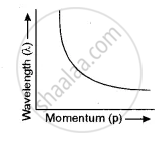Advertisements
Advertisements
प्रश्न
Show with the help of a labelled graph how their wavelength (λ) varies with their linear momentum (p).
उत्तर
The relation between λ and p is
λ = `h/p`
Clearly, λ ∝ `1/p` i.e.; p increases λ decreases as shown by the graph.
APPEARS IN
संबंधित प्रश्न
Describe the construction of photoelectric cell.
Crystal diffraction experiments can be performed using X-rays, or electrons accelerated through appropriate voltage. Which probe has greater energy? (For quantitative comparison, take the wavelength of the probe equal to 1 Å, which is of the order of inter-atomic spacing in the lattice) (me = 9.11 × 10−31 kg).
When a light wave travels from air to glass
A proton and α-particle are accelerated through the same potential difference. The ratio of the de-Broglie wavelength λp to that λα is _______.
An electromagnetic wave of wavelength ‘λ’ is incident on a photosensitive surface of negligible work function. If ‘m’ mass is of photoelectron emitted from the surface has de-Broglie wavelength λd, then ______.
Two particles A1 sand A2 of masses m1, m2 (m1 > m2) have the same de Broglie wavelength. Then ______.
- their momenta are the same.
- their energies are the same.
- energy of A1 is less than the energy of A2.
- energy of A1 is more than the energy of A2.
A particle moves in a closed orbit around the origin, due to a force which is directed towards the origin. The de Broglie wavelength of the particle varies cyclically between two values λ1, λ2 with λ1 > λ2. Which of the following statement are true?
- The particle could be moving in a circular orbit with origin as centre.
- The particle could be moving in an elliptic orbit with origin as its focus.
- When the de Broglie wavelength is λ1, the particle is nearer the origin than when its value is λ2.
- When the de Broglie wavelength is λ2, the particle is nearer the origin than when its value is λ1.
The ratio of wavelengths of proton and deuteron accelerated by potential Vp and Vd is 1 : `sqrt2`. Then, the ratio of Vp to Vd will be ______.
How will the de-Broglie wavelength associated with an electron be affected when the velocity of the electron decreases? Justify your answer.
How will the de-Broglie wavelength associated with an electron be affected when the accelerating potential is increased? Justify your answer.
